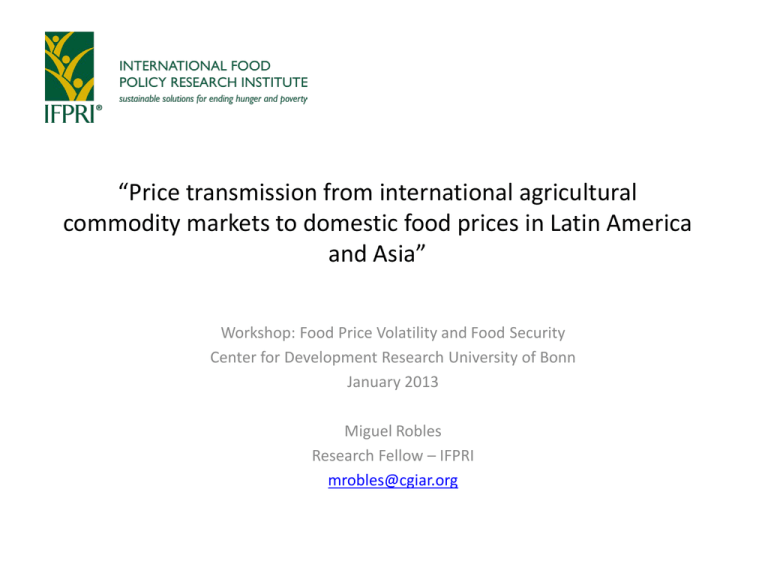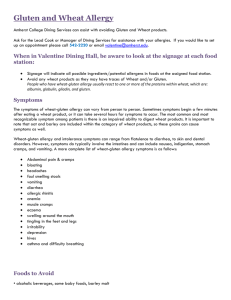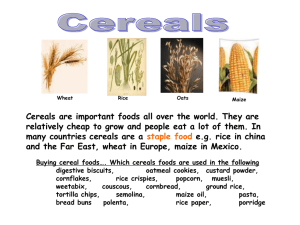“Price transmission from international agricultural
advertisement

“Price transmission from international agricultural commodity markets to domestic food prices in Latin America and Asia” Workshop: Food Price Volatility and Food Security Center for Development Research University of Bonn January 2013 Miguel Robles Research Fellow – IFPRI mrobles@cgiar.org Outline 1. Introduction 2. Methodology 3. Asia – DATA Asia – Results 4. Latin America (LAC) – DATA LAC – Results 5. Final comments 1. Introduction • This work was originally motivated by the 2007-08 food crisis, when international wheat and corn prices x 2 and rice prices x 3 in 12 months • At the time we wanted to understand how much of the variation in international prices was transmitted to domestic food prices and ultimately what was the impact of that on households’ welfare, especially for the poor • Here I’m presenting the price transmission analysis of two studies: – “Price transmission from international agricultural commodity markets to domestic food prices: The case of Bangladesh, Pakistan and Vietnam” – “Assessing Impact of Increased Global Food Prices on the Poor in Selected Latin American Countries” 2. Methodology 1. Price levels and growth rate of prices (first differences) - Price series are I(1) all over the place econometric analysis with growth rates 2. Transmission effects might take more than one period or they may come with time lags. 3. Other factors might affect domestic prices (exchange rate). 4. Different transmission effects depending on domestic location (cities) 5. Different transmission effects depending on domestic food (impact on wheat flour, bread, pasta, etc.) 2. Methodology • We use available historical monthly price time series • Four different types of analysis in comparing prices of a given international commodity with a related domestic food price. 1. Graphical representation (12-month growth rate) 2. Focus on food crisis period: 12-month growth rates, on a quarterly basis, for years 2006–2008. 3. Correlation analysis (A more formal concept of co-movement). • Price series in levels (affected by a common trend) • Growth rates (Not affected by a common trend) 2. Methodology 4. Econometric approach: moving average first-difference regression models (Rigobon 2008) ∗ ) d ln(𝑃𝑃𝑡𝑡 ) = 𝛼𝛼0 + 𝛽𝛽0 d ln(𝑃𝑃𝑡𝑡∗ ) + ⋯ + 𝛽𝛽5 dln(𝑃𝑃𝑡𝑡−5 + 𝛾𝛾0 d ln(𝐸𝐸𝑡𝑡 ) + ⋯ + 𝛾𝛾5 dln(𝐸𝐸𝑡𝑡−5 ) + 𝜀𝜀𝑡𝑡 – Pt : – Pt * : – Et : domestic price in local currency in period t international prices in US dollars in period t exchange rate in period t • Price transmission elasticity = 5 � 𝛽𝛽𝑖𝑖 𝑖𝑖=0 𝜀𝜀𝑡𝑡 ~𝑖𝑖𝑖𝑖𝑖𝑖 3. ASIA - DATA • Countries: Bangladesh, Pakistan and Vietnam • International prices: monthly, from the International Commodity Price Database of the Food and Agriculture Organization (FAO) – Wheat US No.2, Hard Red Winter, US Fob Gulf, – Rice White Broken Rice, Thai A1 Super, Fob Bangkok. • Domestic prices – FAO - Global Information and Early Warning System (Bangladesh, Pakistan) – General Statistics Office of Vietnam • Exchange rates: International Monetary Fund (IMF). 3. ASIA - DATA Country Commodities Cities Period Bangladesh Wheat (wholesale) Rice (wholesale) Dhaka National 1998m7 – 2010m3 Pakistan Wheat Wheat flour Rice basmati Rice irri Karachi Lahore Multan Peshawar Quetta 2006m1 – 2010m3 Vietnam Rice Wheat flour Hanoi Son La Da Nang HCMC Dak Lak Lam Dong Tien Giang Dong Thap Can Tho 2001m1 – 2008m12 3. Results: Bangladesh 3. Results: Bangladesh Bangladesh: Price transmission elasticities Wheat Dhaka, wholesale National, wholesale Transmission elasticity Standard error Significance level 0.583880 0.136560 0.000038 0.700098 0.120119 0.000000 Bangladesh: Price transmission elasticities Rice Dhaka, wholesale National, wholesale Transmission elasticity Standard error Significance level 0.438651 0.113837 0.000187 0.425959 0.105925 0.000101 3. Results: Pakistan - wheat 3. Results: Pakistan - rice 3. Results: Pakistan Pakistan: Price transmission elasticties Transmission elasticity Wheat Karachi, retail 0.5014 Lahore, retail 0.2836 Multan, retail 0.3550 Peshawar, retail 0.8220 Karachi flour retail -0.3353 Lahore, flour retail -0.2591 Multan, flour retail 0.0081 Peshawar, flour, retail 0.3137 Quetta, flour, retail 0.0039 Pakistan: Price transmission elasticties Transmission elasticity Rice Karachi, basmati, retail Lahore, basmati, retail Multan, basmati, retail Peshawar, basmati, retail Quetta, basmati, retail Karachi, irri, retail Lahore, irri, retail Multan, irri, retail Peshawar, irri, retail Quetta, irri, retail 0.4014 0.5327 0.4840 0.6232 0.4679 0.5350 0.6488 0.7906 1.0042 0.7092 Standard error Significance level 0.1955 0.1971 0.1838 0.2807 0.3397 0.3444 0.2262 0.2795 0.3984 0.0152 0.1598 0.0623 0.0062 0.3311 0.4575 0.9715 0.2700 0.9923 Standard error Significance level 0.2821 0.2533 0.2146 0.2230 0.2059 0.2377 0.2391 0.2620 0.2604 0.3703 0.1645 0.0434 0.0311 0.0087 0.0299 0.0314 0.0106 0.0050 0.0005 0.0644 3. Results: Vietnam 3. Results: Vietnam Vietnam: Price transmission elasticities Transmission elasticity Wheat Hanoi -0.2505 Son La 0.0746 Da Nang 0.1224 HCMC 0.2923 Dak Lak 0.2143 Lam Dong 0.2000 Tien Giang 0.3575 Dong Thap -0.0054 Can Tho 0.0988 Vietnam: Price transmission elasticities Transmission elasticity Rice Hanoi 0.9093 Son La 0.3897 Da Nang 0.2550 HCMC 0.5602 Dak Lak 0.4992 Lam Dong 0.2869 Tien Giang 0.4733 Dong Thap 0.2638 Standard error Significance level 0.1746 0.1300 0.0513 0.1143 0.1203 0.1026 0.0923 0.1305 0.0988 0.1554 0.5677 0.0194 0.0125 0.0788 0.0548 0.0002 0.9674 0.3207 Standard error Significance level 0.1750 0.1155 0.0473 0.0895 0.1403 0.0891 0.1036 0.1194 0.0000 0.0012 0.0000 0.0000 0.0006 0.0019 0.0000 0.0301 3. ASIA. Summary of findings • For large international price shocks transmission (co-movement) is evident. Evidence suggests that during food crisis (2007-2008) domestic prices responded in all three countries and almost all cities. • For larger time horizons (moderate price fluctuations) transmission effects are also present but less evident. • Transmission effects are heterogeneous across countries, across products and across cities within a country • In Bangladesh, there is high transmission elasticity for both rice and wheat. This transmission is stronger for wheat (0.7) than for rice (0.43) 3. ASIA. Summary of findings • In Pakistan high transmission for rice (both irri and basmati) : range 0.53– 1.0. Wheat transmission is on average lower, and more variation across cities: in the range 0 - 0.82. No transmission for wheat flour • In Vietnam: positive rice transmission in the range 0.3 - 0.9. For wheat flour, transmission effects are lower (only positive in 5 out of 9 cities ranging from 0.12 to 0.35) 4. DATA - LAC • Países en LAC: • • • • • • • • • • México Guatemala El Salvador Honduras Nicaragua Costa Rica Panamá República Dominicana Ecuador Perú 4. Data - LAC • International prices: monthly, from the International Commodity Price Database of the Food and Agriculture Organization (FAO) – U.S. Gulf of Mexico, No. 2 yellow corn – U.S. Gulf of Mexico No. 2 soft red winter wheat – Thai A1 white broken rice at Bangkok • Exchange rates: International Monetary Fund (IMF). • Domestic prices: monthly series from national Bureau of Statistics wheat related Mexico Guatemala El Salvador Honduras Nicaragua sweet_bread white_bread bread_decaja bread bread bread_sweet bread_loaf bread_semitas pasta macaroni crackers spaghetti crackers bread bread_loaf bread_loaf_sliced spaghetti crackers cookies wheat_flour candy_polvoron cookies other_cookies wheat_flour pastry corn related rice related Period tortillas corn corn_flour wheat_flour pastry tortillas corn tortillas corn cornflakes rice tortillas corn corn_flour corn_milling rice rice rice tortillas corn corn_flour cornflakes rice 1989m1 2008m10 2000m12 2008m4 1995m1 2008m3 2000m3 2008m3 2000m3 2008m3 wheat related Costa Rica Panama Dominican R. bread bread_square bread_sweet bread bread 1 bread 2 pasta crackers pasta spaghetti crackers cookies wheat_flour corn related flour cereals Ecuador Peru bread_cereals_gra bread ins bread_baguette (price index) pasta spaghetti cookies flour tortillas corn corn_flour rice related Period rice rice 2000m1 2008m4 2003m1 2008m3 rice rice selected rice premium 2003m1 2008m3 rice 2005m1 2008m10 1996m1 2008m9 4. LAC Results - Wheat LAC - Price transmission: int. wheat to domestic bread 0.70 0.60 0.50 0.40 0.30 0.20 0.10 Dom. Rep. Peru Panama Nicaragua Mexico Honduras Guatemala El Salvador Ecuador C.Rica 0.00 4. LAC Results – Wheat flour LAC - Price transmission: int. wheat to domestic flour 0.70 0.60 0.50 0.40 0.30 0.20 0.10 Dom. Rep. Peru Panama Nicaragua Mexico Honduras Guatemala El Salvador Ecuador C.Rica 0.00 4. LAC Results - Pasta LAC - Price transmission: int. wheat to domestic pasta 0.70 0.60 0.50 0.40 0.30 0.20 0.10 Dom. Rep. Peru Panama Nicaragua Mexico Honduras Guatemala El Salvador Ecuador C.Rica 0.00 4. LAC Results - Rice 0.70 0.60 0.50 0.40 0.30 0.20 0.10 0.00 -0.10 -0.20 -0.30 -0.40 -0.50 C.Rica Ecuador El Salvador Guatemala Honduras Mexico Nicaragua Panama Peru Dom. Rep. LAC Price transmission: int. rice to domestic rice 4. LAC Results - Corn Nicaragua Mexico Honduras Guatemala El Salvador Ecuador 0.70 0.60 0.50 0.40 0.30 0.20 0.10 0.00 -0.10 -0.20 -0.30 -0.40 -0.50 C.Rica LAC - Price transmission: int. corn to domestic corn 4. LAC Results - Tortillas LAC - Price transmission: int. corn to domestic tortilla 0.70 0.60 0.50 0.40 0.30 0.20 0.10 -0.40 Nicaragua Mexico Honduras Guatemala -0.30 El Salvador -0.20 Ecuador -0.10 C.Rica 0.00 4. LAC Summary of findings • WHEAT: – Positive transmission elasticities in most countries for bread, wheat flour and pasta – Averages and min – max • Bread 0.20 ( 0.10, 0.45 ) • Wheat flour 0.30 ( 0.15, 0.65 ) • Pasta 0.24 ( 0.18, 0.32 ) • RICE: – Other than Panama and DR Positive transmission elasticities – Averages and min – max • 0.18 ( -0.15, 0.50 ) • CORN: – Mostly none or very low transmission for corn and tortillas. 5. Final Price transmission. Summary of findings, final comments • This presentation was about POSITIVE ECONOMICS: estimate the degree of transmission! • NORMATIVE ECONOMICS: – Should we advocate for high or low price transmission? – Prices are key economic variables in a market economy for consumption and production decisions – As far as international prices summarize and respond to fundamentals we want high transmission to domestic prices? – Question is what to do if international prices do not respond to fundamentals? – Keep in mind that: • Price movements generate losers and winners • Policies to control prices are poorly targeted • Policies to protect vulnerable groups must be put in places (market economy won’t prevent corner solutions)



